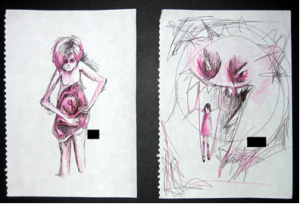- Calls to this hotline are currently being directed to Within Health or Eating Disorder Solutions
- Representatives are standing by 24/7 to help answer your questions
- All calls are confidential and HIPAA compliant
- There is no obligation or cost to call
- Eating Disorder Hope does not receive any commissions or fees dependent upon which provider you select
- Additional treatment providers are located on our directory or samhsa.gov
Art Therapy and Bingeing
Contributor: Sondra Rosenberg, ATR-BC Creative Arts Therapy Supervisor at The Renfrew Center of Philadelphia

What constitutes a binge?
We all overeat at times, but binge-eating is eating well past the point of fullness. The amount of food that constitutes a binge is variable, but someone who is bingeing typically feels out of control and unable to stop. Some people follow binges with compensatory behaviors like purging, exercising or restricting, though some do not. Not everyone who binges is overweight – it is a behavior and a relationship to food that does not necessarily correspond with size.

Why do people binge?
There are many reasons why people binge. First and foremost, it’s an effective way of numbing and distracting individuals from uncomfortable feelings like anxiety and boredom. It is an attempt to fill emotional and spiritual hungers with food. Bingeing is also a direct consequence of dieting or having a diet mentality.
Bingeing brings out a rebellious part of us that rejects the rules set by our more controlling selves. When we allow ourselves to have the forbidden food, we feel guilty and turn it into a method of self-punishment eating far more than what actually feels good. It can feel like giving up on the idea that you are good and sinking into a place of hopelessness, where you feel completely unacceptable for wanting and giving yourself what you want.
Art therapy and binge-eating

I also see a lot of food collages, where abundant images of highly caloric foods are presented as tempting but overwhelming. These collages visually articulate a central dilemma of the binge-eater – the demonization of desire and the equation of pleasure with sinfulness, an association that has deep roots in many religions around the world as well as a theme echoed repeatedly in food advertisements.
The art therapy room at The Renfrew Center becomes a safe space to explore all of these feelings and ideas. Creative self-expression provides a way to engage with and contain difficult feelings – the patient externalizes their inner experience and is then able to step back and contemplate it, thereby giving much needed perspective, as well as the satisfaction of seeing one’s unseen internal world reflected back in a tangible way.
When images like the ones described above emerge in the studio, it facilitates a process of articulating that which had previously been inchoate. We can ask questions about the voids; rearrange collages to reflect new, healthier relationships with food and the landscape of consumerism. We can create a dialogue with the monsters and see what they have to say. Often times, they are just vulnerable, rejected parts of us that have grown monstrous inside because they are very much in need of our love and attention.
Using art to explore your feelings about food

Think about what you are truly hungry for in your life – draw or create a collage reflecting those things.
Create an art project about a food related memory, one that has a strong emotional charge or a food that you binge on. For example: draw a memory involving chocolate – sometimes specific foods have a strong emotional charge because they remind us of people and experiences from our past – when we get hungry for those connections, we often reach for the foods that remind us of them.
Depict what it feels like before during and after a binge – notice what kinds of feelings give rise to bingeing, what happens to those feelings during the binge and what the aftereffects are.
Create a set of self-care cards with grounding imagery like trees to look at in those moments when you are tempted to numb out with food.
Other ways to explore your relationship with food

What are you allowing yourself in a binge that you aren’t allowing yourself in your life, both in terms of food (not allowing yourself to have sweets and then eating a whole box of cookies) and how you are in the world? For instance, do you hold back your feelings to the breaking point and then take everything out on yourself when you are alone? Do you spend a lot of energy trying to take care of other people, then feel depleted and use food to feed your own emotional hungers? What would it mean to give yourself permission to want?
How might the foods that you tend to binge on reflect what you are hungry for in your life? Map out all the associations you have to the foods that you crave the most and they will tell you about the deepest desires of your heart.
Next time you want to binge, ask yourself what you are feeling in the moment. The feelings you identify are the ones you probably need to build tolerance for. What would it be like to just feel your feelings instead of eating them away? You can notice the physical sensations of the feelings and the thoughts that go through your mind, then work on attending to what your body needs and engaging in supportive self-talk or reach out to a friend for support.

Work to break the ties in your mind between how you eat and how your body looks. When you are in your body, it’s fairly simple to eat what you want when you are hungry and stop when you’re full. However, if you are disconnected from your body and preoccupied with judgments about it, you’re much more likely to get stuck in a cycle of dieting and bingeing. When deciding if you want to eat something, leave body image out of the equation. Focus on how you feel and what you truly want.
To stop bingeing requires a willingness to be vulnerable and consider that what we have always regarded as a core of hopelessness may in fact be something wonderful within us that is in need of care and love. If you or someone you love is struggling with binge eating disorder speak with your primary care physician or a treatment facility, such as The Renfrew Center, which specializes in this type of care.
Community Discussion – Share your thoughts here!
What impact has art therapy had on your recovery from disordered eating? What advice do you have to share?
About the author:

The opinions and views of our guest contributors are shared to provide a broad perspective of eating disorders. These are not necessarily the views of Eating Disorder Hope, but an effort to offer a discussion of various issues by different concerned individuals. We at Eating Disorder Hope understand that eating disorders result from a combination of environmental and genetic factors. If you or a loved one are suffering from an eating disorder, please know that there is hope for you, and seek immediate professional help.
Last Updated & Reviewed By: Jacquelyn Ekern, MS, LPC on September 18, 2015. Published on EatingDisorderHope.com
